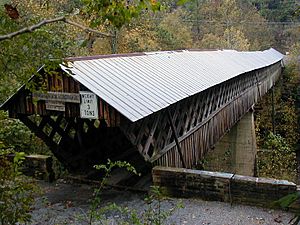Horton Mill Covered Bridge facts for kids
Quick facts for kids Horton Mill CB |
|
|---|---|

The Horton Mill Covered Bridge near Oneonta, Alabama, before its recent restoration
|
|
| Coordinates | 34°00′27.52″N 86°26′55.05″W / 34.0076444°N 86.4486250°W |
| Carries | single lane motor traffic |
| Crosses | Calvert Prong of the Little Warrior River |
| Locale | Oneonta, Alabama |
| Maintained by | Alabama Historical Commission |
| ID number | 01-05-07 (WGCB) |
| Characteristics | |
| Design | Town Lattice truss |
| Total length | 220 ft (67 m) |
| Width | 10 ft (3 m) clearance |
| Load limit | 3 US tons (2.72 metric tons) |
| Clearance above | 8 ft (2 m) |
| History | |
| Construction end | 1934 |
The Horton Mill Covered Bridge is a special wooden bridge in Blount County, Alabama, United States. It stretches across the Calvert Prong of the Little Warrior River. You can find it about 5 miles (8 kilometers) north of Oneonta. This bridge is unique because it is one of the few remaining covered bridges in the area.
Built in 1934, the bridge is 220 feet (67 meters) long. It uses a special design called a Town Lattice truss. This design uses many crisscrossing wooden beams to make the bridge strong. The Horton Mill Covered Bridge was added to the National Register of Historic Places on December 29, 1970. It was the very first covered bridge in the southeastern U.S. to get this important recognition.
This bridge is also special because it is the highest covered bridge above any U.S. waterway, standing 70 feet (21 meters) high. After being closed for repairs in 2007, it reopened on March 11, 2013. Cars can still drive across it, but only one at a time, and the speed limit is very slow at 5 MPH. The Alabama Historical Commission helps take care of this historic bridge.
Contents
History of the Horton Mill Covered Bridge
The first Horton Mill Covered Bridge was built in 1894. It was located about 3/4 mile (1 kilometer) downstream from where the current bridge stands. This first bridge was named after Thurman M. Horton, who owned a local business and helped build it. The bridge made it easier for people from Sand Mountain to reach Oneonta and Horton's mill and general store.
Building the Current Bridge
Construction on the current Horton Mill Covered Bridge started in 1934. It was built over a deep gorge carved by the river. Talmedge Horton, a relative of Thurman Horton, led the project. A team of 15 workers spent about 1½ years building it. Zelma C. Tidwell, who was the foreman, also helped build three other famous covered bridges in Blount County: the Easley, Nectar, and Swann bridges.
In 1974, the bridge was fully restored by the Alabama Historical Commission and the Blount County Commission. Today, it is one of only three historic covered bridges left in Blount County.
Bridge Closures and Repairs
The Horton Mill Covered Bridge was closed to traffic on September 27, 2007. This was because it became unsafe. Sadly, some people tried to damage the bridge by pulling on its roof supports with a vehicle. This caused a lot of damage. The other two historic covered bridges in Blount County, Easley and Swann, were also closed in 2009 after inspections showed they were unsafe.
Repairs for all three covered bridges began in late 2011. Money for these projects came mostly from a federal program that helps save historic covered bridges. The Horton Mill Covered Bridge was the last one to be fixed. This was because it was so high above the river, which made the work more difficult. Workers repaired or replaced damaged wooden parts. They also put new tin roofs on all three bridges to protect the wood from weather.
After all the necessary repairs, the Horton Mill Covered Bridge reopened to cars on March 11, 2013.
Protecting the Bridges
In late 2015, cameras were put in place at all three remaining covered bridges in Blount County. This was done to help stop vandalism, like when graffiti was found on the Easley Covered Bridge a year earlier. The graffiti has since been cleaned off.
Bridge Measurements
Here are some approximate measurements for the Horton Mill Covered Bridge:
- Main Span Length: 80.1 feet (24.4 meters)
- Total Span Length: 208.0 feet (63.4 meters)
- Deck Width: 11.2 feet (3.4 meters) (This is how wide the road part is)
- Vertical Clearance: 8.5 feet (2.6 meters) (This is how tall a vehicle can be to fit under the roof)
- Underclearance: 70.0 feet (21.3 meters) (This is how high the bridge is above the river)
Other Facts
The Horton Mill Covered Bridge is so important that it is even shown on the official seal of the Blount-Oneonta Chamber of Commerce.
Images for kids
See also
 In Spanish: Puente cubierto de Horton Mill para niños
In Spanish: Puente cubierto de Horton Mill para niños


